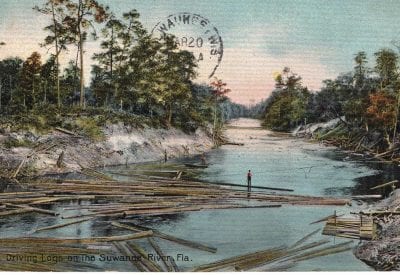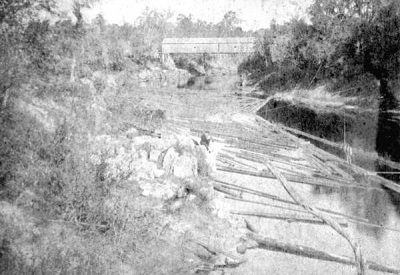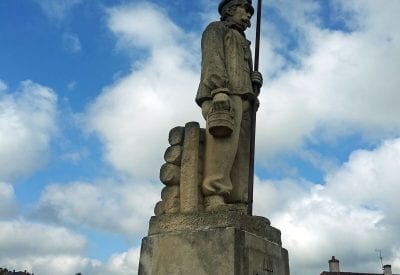Florida Waterways
“Floating Logs on Our Rivers”
By Kevin McCarthy
In boating the Yonne Canal in France in May of this year, I came upon a statue on a bridge dedicated to the “Floaters of Clamecy.” I learned that every July, the people there pay tribute to the so-called “Wood Floaters” from the past. The “fête du flottage” [floating festival] harkens back to the 16thcentury, when hardy rivermen transported many logs from Burgundy to Paris on timber rafts, logs that would be used for heating and cooking.
In 19th-century Florida, river workers did something similar: floating logs on rivers like the Suwannee. Timbermen cut down trees along the way, pushed them into rivers like the Suwannee, and guided them to sawmills, which would cut the trees into workable lumber. In 1865, Florida Governor George Franklin Drew built what at the time was the largest sawmill in the state, on the west side of the Withlacoochee River, just above where the river joins the Suwannee. Today the site is near the Suwannee River State Park.
The Hillsborough River near Tampa was the site where ships unloaded cedar logs from British Honduras, for the making of cigar boxes in the nearby factories in the early 1900s. The arriving ships would blow their loud whistles and dump the logs into the river. Workers would then chain the logs together and string them along both sides of the river. Later, other workers would use a large crane, which was on a track, to take the logs out of the water, transport them into a pile in a field, cut them into six-foot lengths at a nearby sawmill, and transport the logs on flatbed trucks to the Tampa Box Company.
In addition to helping ships to transport logs up the river, the Hillsborough allowed lumber men to float cedar logs down to Tampa sawmills from the upper reaches of the river, where they were cut down and trucked to the waterway. In the 1850s, one of the most important personages in the early history of Tampa, James McKay, shipped out cedar logs to New York for the making of objects like pencils.
According to McKay’s son, James McKay Jr., the elder McKay used the sawdust from the mill on Tampa’s streets to assist mules or horses in hauling the wood. When yellow fever struck the town, however, many local citizens thought the sawdust was responsible for causing the disease, and forced a halt to that practice.
Today, entrepreneurs are often diving our Florida rivers to look for logs that have sunk to the bottom – to be retrieved and used again in construction.
Kevin McCarthy, the author of North Florida Waterways2013 (available at amazon.com), can be reached at ceyhankevin@gmail.com.






